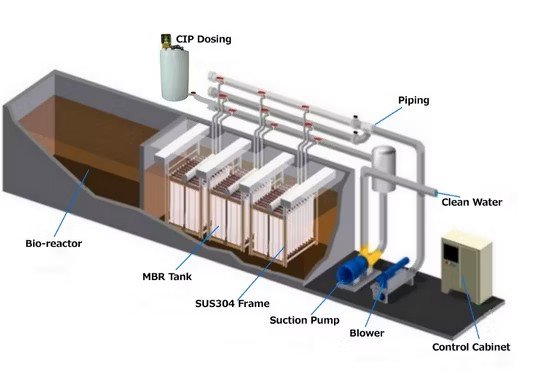Explore Our Partnered Factory Technologies
Top-Performing Solutions
Integrated Wastewater Treatment Unit
Equipment introduction
An integrated wastewater treatment unit is a compact system that combines essential treatment components—including anoxic tanks, anaerobic tanks, aerobic tanks, sedimentation tanks, sludge tanks, disinfection chambers, and equipment rooms—into a single modular design. By incorporating mechanical aeration within the aerobic tank, it effectively merges the principles of contact oxidation and activated sludge processes. This hybrid approach leverages the strengths of both methods while overcoming their limitations, significantly enhancing treatment efficiency. The primary purpose of this system is to treat small-scale domestic sewage and similar industrial wastewater to meet user-defined discharge standards.
Designed for versatility, the unit can be installed either above-ground or buried underground. Its adaptable configurations accommodate diverse spatial constraints and terrains, making it ideal for decentralized applications such as residential communities, villages, office buildings, hotels, schools, factories, tourist sites, as well as small-scale industrial facilities (e.g., slaughterhouses, aquatic product processing plants, and food production units) requiring organic wastewater treatment.
working principle
The integrated wastewater treatment system employs the well-established biochemical technology of the contact oxidation process, primarily designed for domestic sewage and analogous industrial organic wastewater treatment.
Treatment Mechanism
Hydrolysis Stage:
Facultative bacteria hydrolyze suspended pollutants (e.g., starch, fibers, carbohydrates) and soluble organic matter into organic acids.
Macromolecular organics are decomposed into micromolecular organics, while insoluble organics are converted into soluble forms.
Enhanced Biodegradability: The hydrolyzed products from the anoxic stage improve biodegradability and oxygen utilization efficiency during subsequent aerobic treatment.
Anoxic Stage:
Ammonification: Heterotrophic bacteria break down proteins, fats, and other pollutants, releasing ammonia (NH₃/NH₄⁺).
Nitrogen Cycle:
Aerobic Nitrification: Under sufficient oxygen supply, autotrophic bacteria oxidize NH₃-N (ammonia nitrogen) to NO₃⁻ (nitrate).
Anoxic Denitrification: Recirculated nitrate (NO₃⁻) is reduced to molecular nitrogen (N₂) by heterotrophic bacteria, completing the ecological cycle of carbon, nitrogen, and oxygen.
Process Overview
The system integrates physical and biochemical processes:
Primary Treatment: Filtration and sedimentation.
Secondary Treatment:
pH adjustment with neutralizing agents.
Flocculant addition for suspended solids removal.
Biological treatment (aeration) and anaerobic digestion, tailored to wastewater composition.
Performance Example (Domestic Sewage)
Influent Quality: COD ≈ 350 mg/L
Effluent Quality: COD ≤ 50 mg/L
Key Advantages
Eco-Friendly: Achieves harmless wastewater discharge through natural nitrogen cycle synchronization.
Compact Design: Modular structure adaptable to decentralized treatment needs.
Energy Efficiency: Optimized aeration reduces operational costs.
Product features
Integrated Wastewater Treatment System
This integrated wastewater treatment system eliminates the use of air compressors, thereby avoiding noise pollution caused by compressor operation. By removing the need for air compressor maintenance and operation, it reduces operational costs while enhancing flotation efficiency.
Key Features
Compact & Rational Design: Space-saving modular structure adaptable to constrained sites.
Energy Efficiency: Low power consumption with stable treatment performance.
Cost-Effective: Reduced upfront investment and rapid return on capital.
Eco-Friendly: Noise-free operation aligns with sustainable practices.
Technical Advantages
Simplified Maintenance: Air compressor-free design minimizes mechanical upkeep.
Optimized Flotation: Improved dissolved air flotation (DAF) performance for superior suspended solids removal.
Scalable Application: Ideal for decentralized wastewater treatment in residential, commercial, and light industrial settings.
Performance Metrics
Noise Level: ≤55 dB (compressor-free operation)
Operational Cost: 20–30% lower than conventional systems with air compressors.










